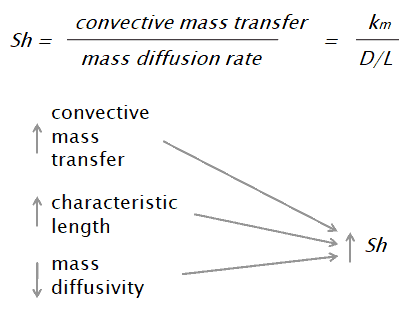What is Sherwood Number
The Sherwood number is a dimensionless number, named after Thomas Kilgore Sherwood. The Sherwood number is defined as the ratio of the convective mass transfer to the mass diffusivity.
The Nusselt and Sherwood numbers represent the effectiveness of heat and mass convection at the surface. The Sherwood number is to the concentration boundary layer what the Nusselt number is to the thermal boundary layer.
The Sherwood number is defined as:
where:
km is convective mass transfer coefficient [m/s]
L is a characteristic length [m]
D is the mass diffusivity [m2/s]
For example, the Sherwood number for a single sphere can be expressed as:
Sh = Sh0 + C.RemSc1/3
where Sh0 is the Sherwood number due only to natural convection and not forced convection.
Diffusivity is encountered in Fick’s law, which states:
If the concentration of a solute in one region is greater than in another of a solution, the solute diffuses from the region of higher concentration to the region of lower concentration, with a magnitude that is proportional to the concentration gradient.
In one (spatial) dimension, the law is:
where:
- J is the diffusion flux,
- D is the diffusion coefficient,
- φ (for ideal mixtures) is the concentration.
The use of this law in nuclear reactor theory leads to the diffusion approximation.
We hope, this article, Sherwood Number, helps you. If so, give us a like in the sidebar. Main purpose of this website is to help the public to learn some interesting and important information about thermal engineering.

